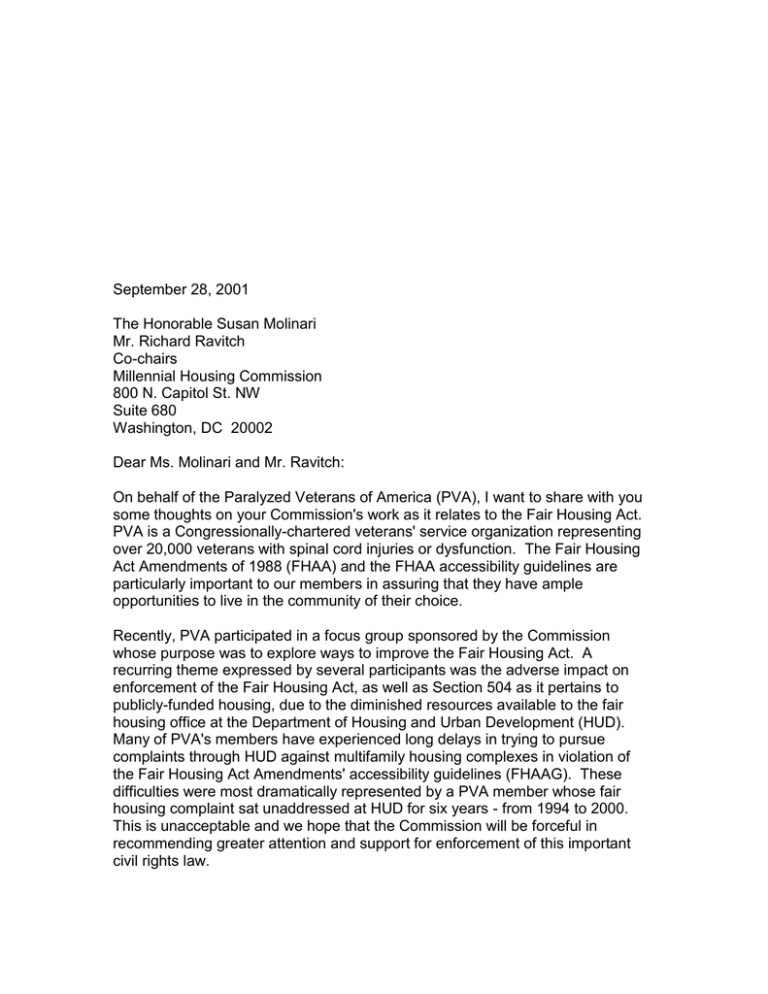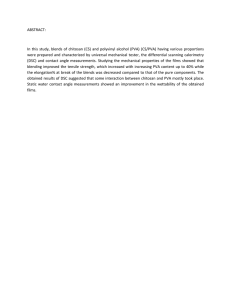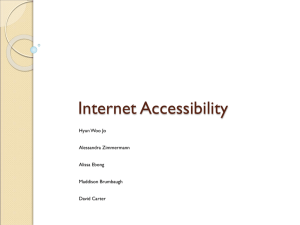September 28, 2001 The Honorable Susan Molinari Mr. Richard Ravitch
advertisement

September 28, 2001 The Honorable Susan Molinari Mr. Richard Ravitch Co-chairs Millennial Housing Commission 800 N. Capitol St. NW Suite 680 Washington, DC 20002 Dear Ms. Molinari and Mr. Ravitch: On behalf of the Paralyzed Veterans of America (PVA), I want to share with you some thoughts on your Commission's work as it relates to the Fair Housing Act. PVA is a Congressionally-chartered veterans' service organization representing over 20,000 veterans with spinal cord injuries or dysfunction. The Fair Housing Act Amendments of 1988 (FHAA) and the FHAA accessibility guidelines are particularly important to our members in assuring that they have ample opportunities to live in the community of their choice. Recently, PVA participated in a focus group sponsored by the Commission whose purpose was to explore ways to improve the Fair Housing Act. A recurring theme expressed by several participants was the adverse impact on enforcement of the Fair Housing Act, as well as Section 504 as it pertains to publicly-funded housing, due to the diminished resources available to the fair housing office at the Department of Housing and Urban Development (HUD). Many of PVA's members have experienced long delays in trying to pursue complaints through HUD against multifamily housing complexes in violation of the Fair Housing Act Amendments' accessibility guidelines (FHAAG). These difficulties were most dramatically represented by a PVA member whose fair housing complaint sat unaddressed at HUD for six years - from 1994 to 2000. This is unacceptable and we hope that the Commission will be forceful in recommending greater attention and support for enforcement of this important civil rights law. Page Two PVA letter to Millennial Housing Commission Another concern is the degree to which the public confuses the Americans with Disabilities Act (ADA) and the Fair Housing Act Amendments. Some consumers with disabilities mistakenly believe they can prosecute instances of housing discrimination through the ADA, which could cause delays in proper administration of justice. Meanwhile, some housing developers have contended that their compliance with ADA and ignorance of the FHAA should absolve them from any penalties for their failure to build according to the FHAA accessibility guidelines. The accessibility guidelines have been in effect for all new multifamily housing since 1991, ample enough time for the housing construction industry to become familiar with their requirements. Clearly, additional education about the FHAA and the accessibility guidelines merits further consideration. However, PVA cautions the Commission against giving so much credence to claims of unfamiliarity with the accessibility guidelines by some in the housing construction community that this could be used in the future by fair housing opponents to press for legislation undermining those guidelines. A weakness in the Fair Housing Act Amendments is the fact that the accessibility guidelines were never required as part of state or local building codes. As a result, building code officials who are responsible for enforcing construction standards rarely consider a building's compliance with the FHAAG in their inspections. Another flaw in the accessibility guidelines is the fact that they have failed to keep up with advancements in housing accessibility. Last year, PVA and several other disability groups were involved with a number of building code organizations in promoting the development and use of building codes that incorporate the Fair Housing Act Accessibility Guidelines (FHAAG). In October 2000, the International Code Council (ICC) published the Code Requirements for Housing Accessibility (CRHA) that provides building code specifications which, if adopted, would enable multifamily housing to be built that meets and even exceeds the FHAAG. PVA believes that the CRHA, as issued by the ICC, offers one of the most useful tools for building accessible multifamily housing. Ideally, communities that adopt a building code should be required to enact one that includes up-to-date accessibility standards. Barring that, PVA believes that greater efforts need to be made to publicize the CRHA and encourage localities and/or states to include the CRHA in their own building codes. To make accessible housing a reality for more people with disabilities, consideration must be given to housing stock in this nation that was built prior to March 1991, when the FHAAG took effect. Apartments and condominiums built before that date are not required to be accessible. However, if an individual wishes to modify a housing unit to make it accessible, he or she may do so at personal expense. For many people with disabilities [or their friends or family members who would like to modify a unit to enhance its accessibility], the costs Page Three PVA letter to Millennial Housing Commission of such renovations can be prohibitive. Sporadic efforts have been made at the state and local level to enact ordinances or tax incentives to encourage people to make accessibility improvements in older housing. Federal tax and other incentives, such as through the Community Development Block Grant program, would be a way to promote accessibility enhancements in older housing on a wider scale. No discussion of housing accessibility is complete without some attention to the low income tax credit properties being built throughout our nation. Federal low income housing tax credit (LIHTC) developments are supposed to be accessible to people with disabilities. Too often, they are not. A memorandum of understanding (MOU) was signed last year between HUD, the Department of Justice and the Internal Revenue Service to identify LIHTC properties in violation of the law and terminate their tax credits. PVA supports this effort and hopes that those agencies will forcefully implement the MOU. Thank you for your attention to our comments. We wish the Commission success in developing its recommendations. Sincerely, Joseph L. Fox, Sr. National President

